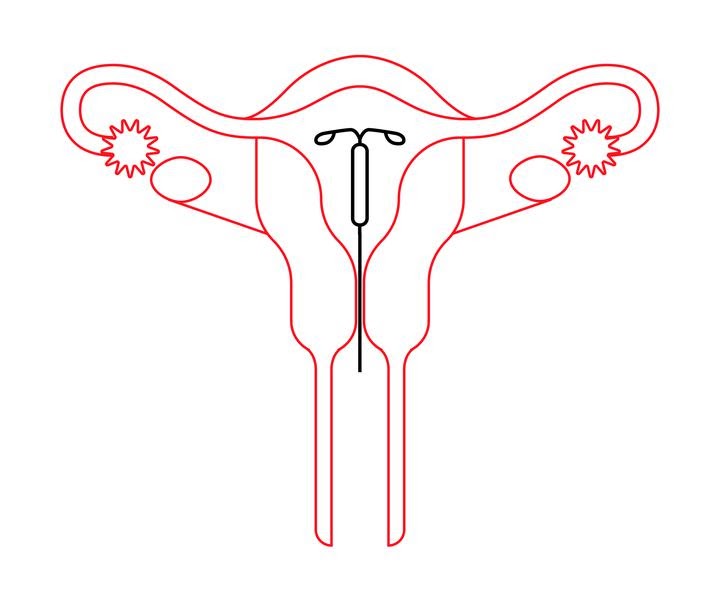Ahhh, yes. The intrauterine device or as it’s better known to the general public – the IUD.
I often lovingly refer to this method of birth control in my own practice as a certified nurse midwife as “The Beyonce of Birth Control” and giiiiirl – I mean it!
It’s not just me either – many people and providers are total cult followers and users – basking in the pure ease and freedom that it provides women when it comes to birth control. On the flip side, this increasingly popular method of birth control sounds scary and foreign to many and honestly freaks people out! In this article, let’s bust a few of the common scary myths and misconceptions about IUD’s. I’ll explain the two most popular types of IUD’s and discuss the risks and benefits. If you’ve ever thought about using an IUD and wondered what the deal is – this article is for you! I hope when you’re done reading you feel confident, empowered and informed as to whether or not an IUD is a good choice for you.

What is an IUD?
 image via bedsider
image via bedsider
In the medical world the IUD also falls under the umbrella category of “LARC” or Long Acting Reversible Contraception. The IUD is a small plastic or copper device the shape of the letter “T” that measures just over an inch long. It’s as thin as, ohh say a few strands of spaghetti and is meant to be inserted and rest within your uterus for up to 7-10 years depending on the type of IUD. All IUD’s are inserted and removed in the same fashion.
After an IUD is removed (which can be done at any time you choose with an appointment), you return to your normal pre-IUD fertility, making this a great birth control for family planning and control over your body – sweet! That’s freedommmmm!
How is it placed?
When receiving an IUD a provider will perform a speculum exam (the same kind of exam they do when you get a pap), and visualize your cervix (the mouth or opening of the uterus that you can feel in the tippy top part of your vagina). Once the cervix can be seen they will use a long thin flexible insertion device to go through the cervix and place the IUD within the uterus. The IUD will be left in the uterus, the insertion device is removed and you are left with two strings that are soft and flexible (similar to soft fishing wire) that will then protrude from (come out of) the cervix into the vaginal canal. The other end of the strings is attached to the IUD within the uterus. Your provider will trim the strings to a few centimeters long, remove the speculum and you are good to go! The entire placement typically takes no longer than 10-15 minutes.
How is it Removed?
These trimmed strings protruding from the cervix are meant to be used for IUD removal – when it’s time is up or when you choose to remove the IUD – the provider will perform another speculum exam and grasp the strings and pull it out quickly (and typically pretty painlessly) in a fast in-office procedure. People usually feel just a small cramp during this process.
Can I feel the IUD? Can my partner?
Most people can find the strings in their own vagina if they try – otherwise you typically have no feeling or knowledge the IUD is in place. During sex, partners often times do not feel the strings, and if they do it’s not bothersome. If they do and it is uncomfortable for them, you can ask your provider to trim the strings of the IUD a tad bit shorter or on an angle. The strings also soften over the first 6 months or so after placement – so your partner may also just be able to wait a few months to no longer feel the strings so prominently.
How effective is the IUD?
The efficacy (or effectiveness) of the IUD is one of the amazing benefits.
Research shows the IUD is over 99% effective at preventing pregnancy. According to some research it has been shown to be as effective if not more effective than getting your tubes tied.
That’s insane, considering it is also completely reversible and returning to fertility is as easy as a simple removal.
Aren’t there different kinds?
There are two categories of IUDs on the market. They work in different ways – while both are very effective, oftentimes users are more suited to one than another depending on personal preference and medical history.
Copper IUD: (Paraguard)
All images from bedsider, an awesome resource on all birth control.
Hormonal IUD: (Mirena, Skyla, Liletta, Kyleena)
Which one should I get?
I’ll break down the big pro’s and con’s of each IUD below to help you decide what sounds good to you – I also recommend the website bedsider and the planned parenthood website to get more information and facts if you’re curious!
Copper IUD
How does it work:The copper IUD works by creating an unfriendly environment for sperm within the uterus and is essentially similar to a spermicide. The copper is the active ingredient, hence this IUD feels more “natural” to many users and is appealing to those who don’t tolerate hormones well or don’t want hormones in their body.
This is a really nice option and works wonderfully for many people. My natural and hormone adverse patients LOVE their copper IUD’s.
How long does it last? The copper IUD may be left implanted for 10 years.
Do I still have a period? The copper within the IUD does not alter your natural menstrual cycle or inhibit ovulation. You will continue to have regular periods every month. For some this is desired – if you want a totally safe and healthy break from periods consider the hormonal IUD (read below).
Other important facts: Copper IUD’s can cause slightly heavier bleeding, more intense cramping and more discomfort around the time of your monthly cycle, therefore if you have heavy periods or bad cramps to begin with you may choose not to use this form of IUD. The good news is – if you get it inserted and then can’t tolerate the heavier periods you can always have it taken out! Additionally, many patients see a decrease in heavier bleeding with cycles after about a year.
Progesterone IUD
How does it work? Hormonal IUD’s work by increasing the thickness of cervical mucous in your uterus making it difficult for sperm to find their way to an egg. Additionally hormonal IUD’s may stop ovulation so there’s no egg to fertilize in the first place. The hormonal IUD secretes a very small amount of progesterone into your uterus over time in order to achieve these outcomes. The majority of the hormones in the IUD stay within the uterus with a very small amount reaching the systemic (full body) circulation, making this form a much lower dose of hormones than any pill you can take.
That is pretty appealing in my opinion! Put the majority of hormones where we need them, not all over your bod!
How long does it last? Depending on the brand you use – the hormonal IUD’s can be effective for anywhere from 3 to 7 years. Mirena and Liletta IUDs work for up to 7 years. Kyleena works for up to 5 years. Skyla works for up to 3 years.
Do I still have a period? Depending on the brand you use as they all have different levels of hormones and we all have different bodies – your period and cycle may be altered or completely stop while using a hormonal IUD. Whooooohooo! It’s also 100% safe and healthy to not have a period while on birth control, if this sounds crazy to you or you want to know more – read my article about why that’s true.
Good to know: Hormonal IUD’s for some may cause spotting, irregular bleeding or a very annoying amount of bleeding (on and off and frequent) for the first 6 months of use while your body adjusts to this device. The good news is that after 6 months – most people have much lighter, less crampy, easier periods or none at all (!!). It can definitely be a little rough those first few months if you’re one of the people who bleeds more often however I always remind my patients that 6 months of can definitely be worth the many years of great protection you don’t have to think about.
A few things to think about:
No birth control is perfect. There are some rare risks associated with every form! There is also always the chance that you become pregnant with an IUD in place – however, as mentioned – this is pretty rare with IUD’s. Pregnancy, infection of the uterus, migration of the IUD, a bleeding pattern you can’t tolerate, the IUD embedding into the uterine wall and perforation of the uterus when the IUD is placed are things that can and have happened to women who use this form of birth control. The risk for these complications is less than 1% though! Thats huge, err hugely small…!
Insertion can be difficult:
If you have never been pregnant or had a baby or it has been many many years since having babies – sometimes the insertion of an IUD can cause discomfort and pain during the process.
Everyone experiences it differently – and again – in my opinion some temporary pain is totally worth the years of great protection you get – but I definitely think it’s important to know in advance it can be tough during insertion.
I recommend taking advil a.k.a ibuprofen an hour or so before you go in for placement as well being ready to rest at home afterwards with a hot pack on your belly and cup of hot tea. I chose to take myself to breakfast afterwards and have a glass of champagne to toast the years of protection I just gave myself. Clink Clink – thats the sound of freedom ladies.
IUD’s don’t prevent sexually transmitted disease!
Don’t forget to use condoms when you’re having sex with new partners – IUD’s are great – but they don’t protect you against everything!
Feeling more informed?
Honestly as a women’s health provider – talking about and educating on IUD’s and other methods of LARC brings me joy and happiness (yes I am a weird womens health nerd, hello!). Why do you ask? Because giving women affordable, long acting, reliable birth control they can Trust with a capital T is a form of empowering and liberating women from fertility they may not want, need, or desire in the moment.
Having babies can be totally wonderful – even as a surprise – but having babies when women choose to have babies and feeling in control of their fertility is one of the best achievements in medicine for modern women.
And the IUD is an awesome way to achieve this! Wheee!







